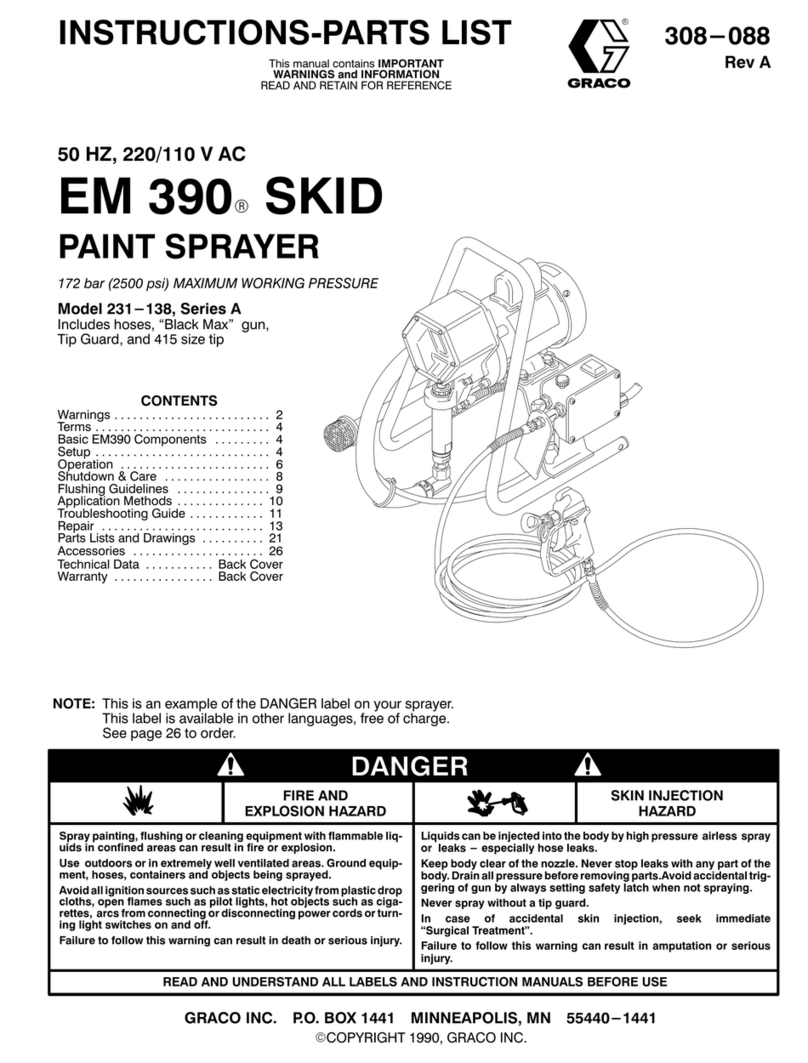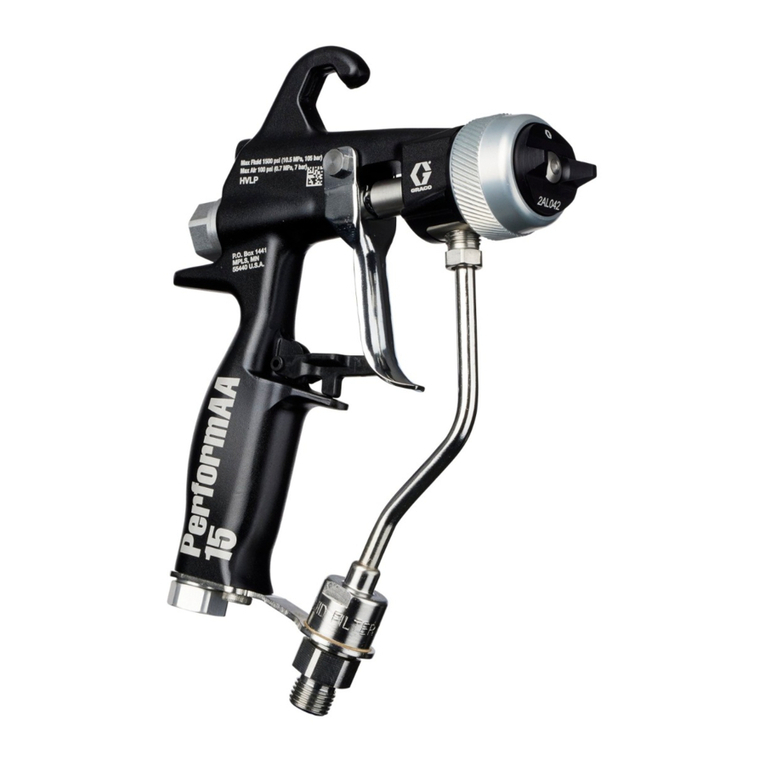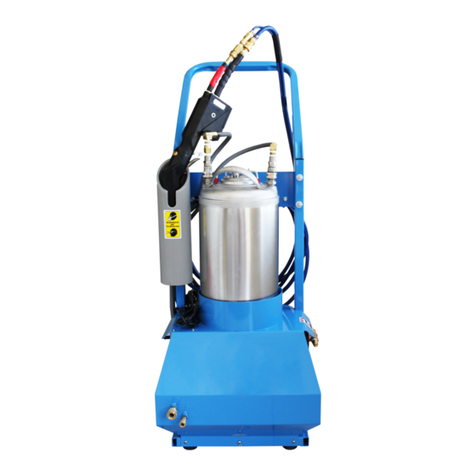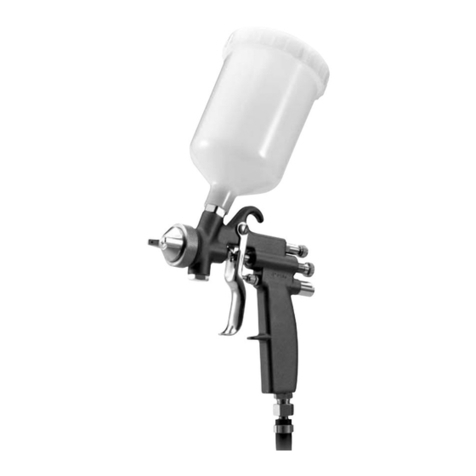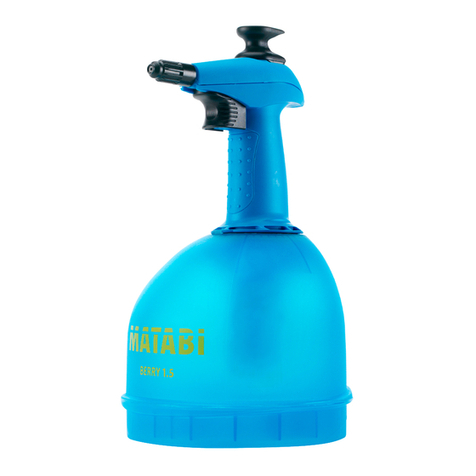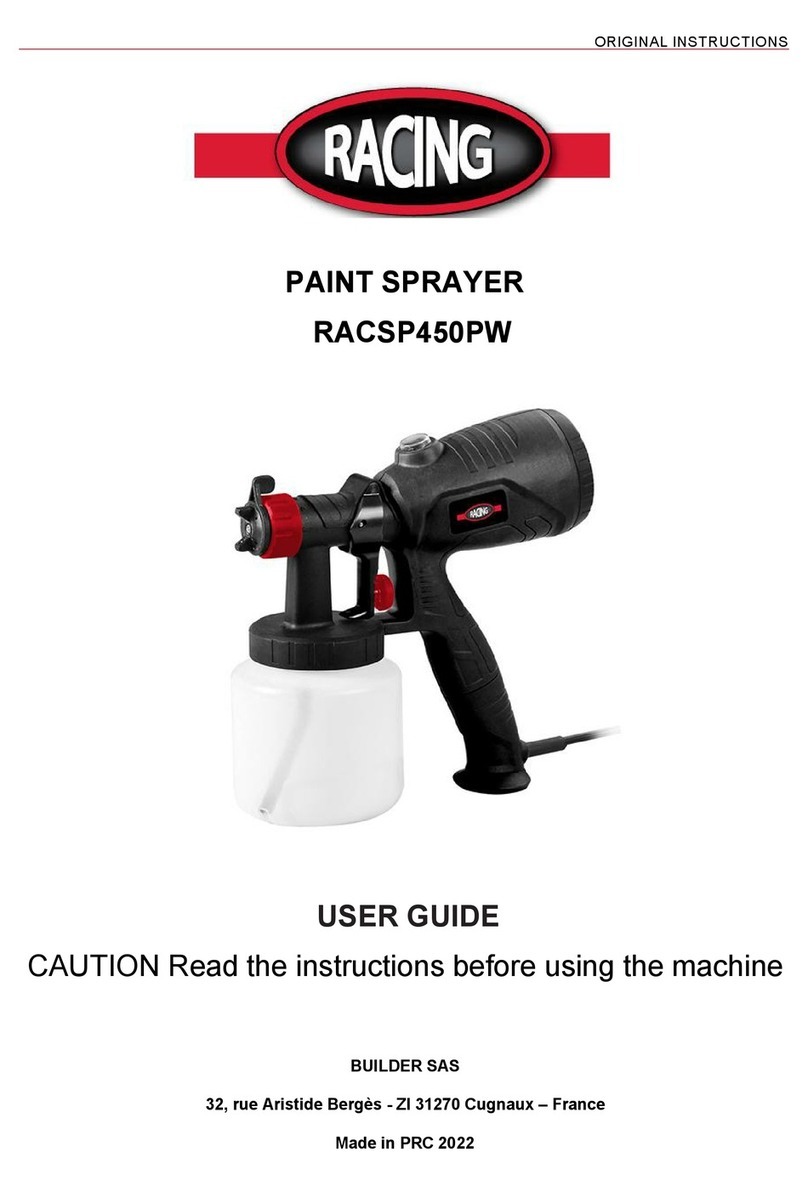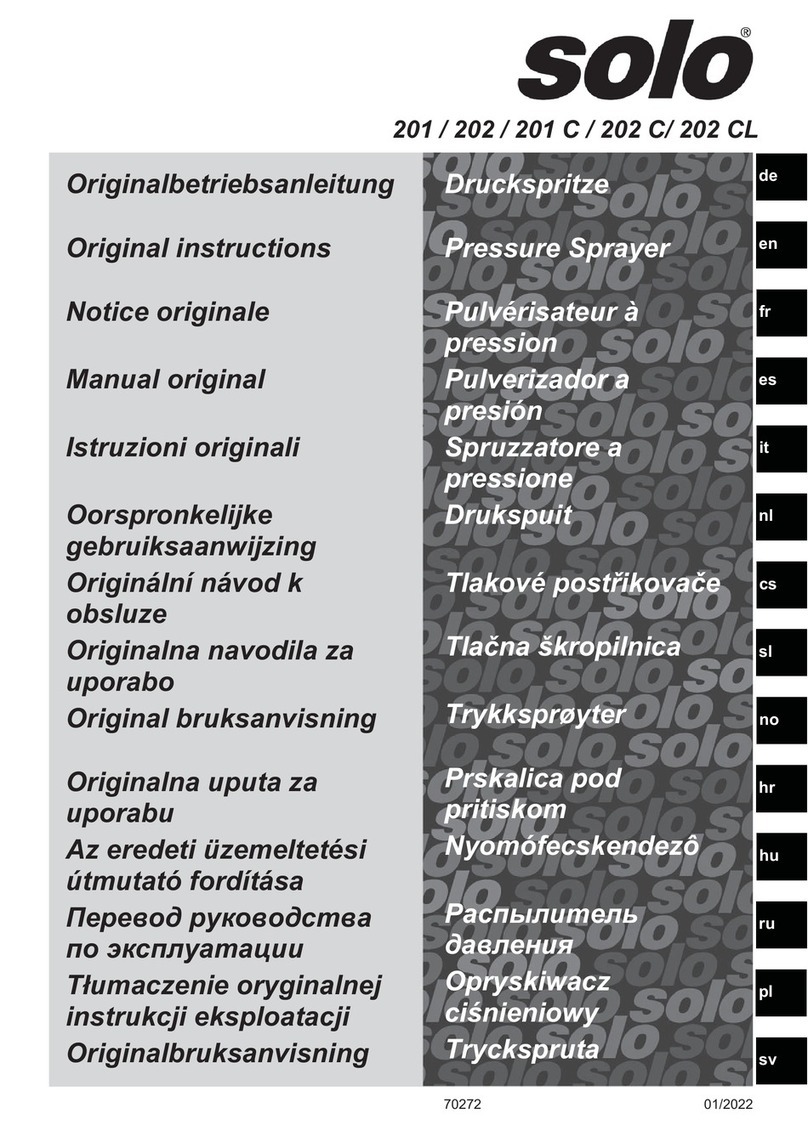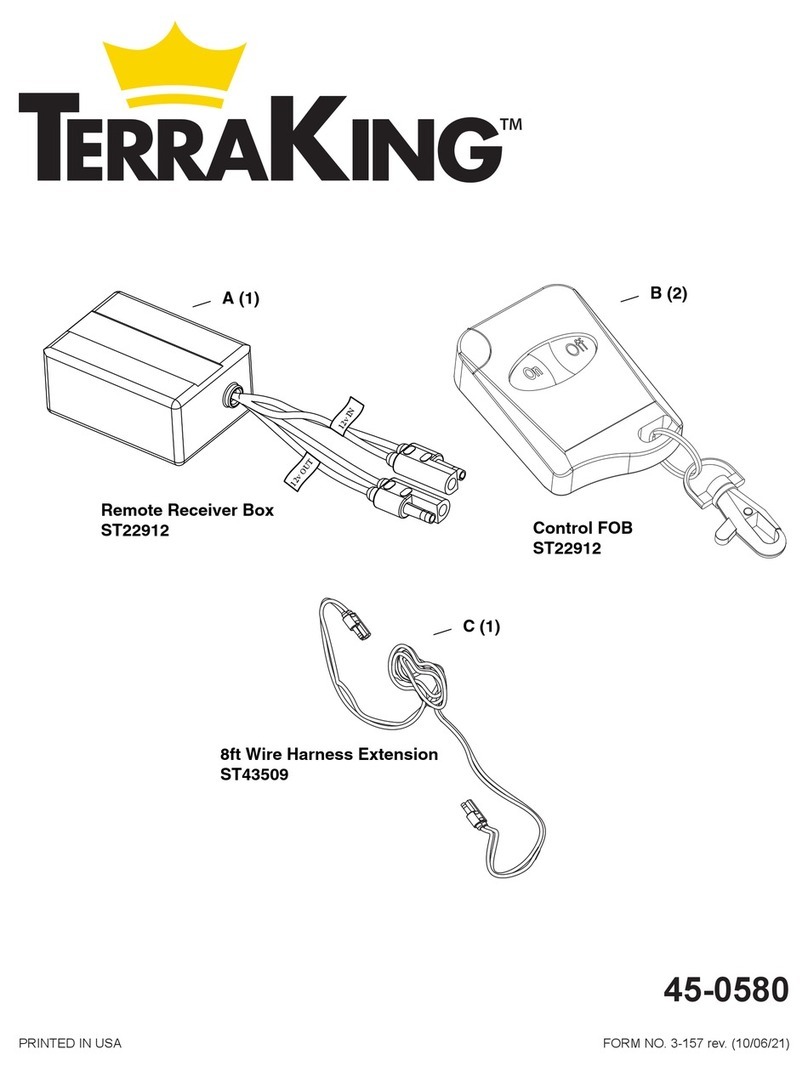Starlyf Total Painter User manual

International patents pending. All imitations will be prosecuted.
TOTAL PAINTER®is a registered EU/CTM trade mark.


ENGLISH
CONTENTS
A. GENERAL SAFETY WARNINGS 7
B. PARTS DETAIL 10
C. GETTING STARTED 10
D. BREAKS 11
E. AFTER USE 11
F. MAINTENANCE 10
G. STORAGE 12
H. ASSEMBLY 12
I. TECHNICAL SPECIFICATIONS 12
ESPAÑOL
INDICE
A. INDICACIONES
GENERALES DE SEGURIDAD 14
B. DETALLE PIEZAS 17
C. PUESTA EN SERVICIO 18
D. INTERRUPCIÓN DE SERVICIO 19
E. PUESTA FUERA DE SERVICIO 19
F. MANTENIMIENTO 20
G. ALMACENAMIENTO 20
H. MONTAJE 20
I. ESPECIFICACIONES TÉCNICAS 21
FRANÇAIS
INDEX
A. INDICATIONS GÉNÉRALES DE
SÉCURITÉ 22
B. LISTE DE PIÈCES 26
C. MISE EN SERVICE 26
D. INTERRUPTION DE SERVICE 28
E. MISE HORS SERVICE 28
F. ENTRETIEN 28
G. RANGEMENT 28
H. MONTAGE 28
I. CARACTÉRISTIQUES
TECHNIQUES 29
DEUTSCH
INHALTSVERZEICHNIS
A. ALLGEMEINE
SICHERHEITSHINWEISE 31
B. DETAILS ZU DEN TEILEN 35
C. INBETRIEBNAHME 35
D. BETRIEBSUNTERBRECHUNG 37
E. AUSSERBETRIEBSETZUNG 37
F. WARTUNG 37
G. LAGERUNG 37
H. ZUSAMMENBAU 38
I. TECHNISCHE DATEN 38
ITALIANO
INDICE
A.INDICAZIONI GENERALI DI
SICUREZZA 40
B. DETTAGLIO PEZZI 43
C. MESSA IN SERVIZIO 44
D. INTERRUZIONI 45
E. MESSA FUORI SERVIZIO 45
F. MANUTENZIONE 46
G. STOCCAGGIO 46
H. MONTAGGIO 46
I. SPECIFICHE TECNICHE 46
PORTUGUÊS
ÍNDICE
A. INDICAÇÕES GERAIS DE
SEGURANÇA 48
B. DETALHE PEÇAS 51
C. COLOCAÇÃO EM SERVIÇO 52
D. INTERRUPÇÃO DO SERVIÇO 53
E. COLOCAÇÃO FORA
DE SERVIÇO 53
F. MANUTENÇÃO 54
G. ARMAZENAGEM 54
H. MONTAGEM 54
I. ESPECIFICAÇÕES TÉCNICAS 55
NEDERLANDS
INHOUDSOPGAVE
A. ALGEMENE
VEILIGHEIDSAANWIJZINGEN 56
B. OVERZICHT ONDERDELEN 60
C. INBEDRIJFSTELLING 60
D. HET GEBRUIK ONDERBREKEN 62
E. BUITEN BEDRIJF STELLEN 62
F. ONDERHOUD 62
G. OPBERGEN 62
H. MONTAGE 62
I. TECHNISCHE KENMERKEN 64

3


5
6

English
Thank you for purchasing the Total Pain-
ter® spray gun. Before you start using it,
please resad the instructions for use and
all the safety warnings carefully. Keep
this manual on hand for future use.
NOTE: TRANSLATION OF THE ORIGI-
NAL INSTRUCTIONS
General Safety Warnings
Errors resulting from failure to adhere
to the following instructions may lead
to electric shock, re and even severe
injury. The substances used with this
spray gun (solvents, paint, etc.) may
contain hazardous, harmful, explosive or
corrosive materials.
WARNING
Read all sa fety warnings
and all instructions. Failu-
re to follow the warnings
and instructions may result
in electric shock, fire and/
or serious injury.
Save all warnings and ins-
tructions for future refe-
rence.
The term “power tool” in
the warnings refers to your
mains-operated (corded)
power tool or battery-
operated (cordless) power
tool.
1) Work area safety
a) Keep work area clean
and well lit. Cluttered or
dark areas invite accidents.
b) Do not operate power
tools in explosive atmos-
pheres, such as in the
presence of flammable
liquids, gases or dust.
Power tools create sparks
which may ignite the
dust or fumes.
c) Keep children and bys-
tanders away while opera-
ting a power tool. Distrac-
tions can cause you to lose
control.
2) Electrical safety
a) Power tool plugs must
match the outlet. Never
modify the plug in any
way. Do not use any adap-
ter plugs with earthed
(grounded) power tools.
Unmodified plugs and
matching outlets will redu-
ce risk of electric shock.
b) Avoid body contact
with earthed or grounded
surfaces, such as pipes,
radiators, ranges and re-
frigerators. There is an
increased risk of electric
shock if your body is ear-
thed or grounded.
c) Do not expose power
tools to rain or wet con-
ditions. Water entering a
power tool will increase the
risk of electric shock.
d) Do not abuse the cord.
Never use the cord for ca-
rrying, pulling or unplug-
ging the power tool. Keep
cord away from heat, oil,
sharp edges or moving
parts. Damaged or entan-
gled cords increase the risk
of electric shock.
e) When operating a
power tool outdoors, use
7

English
an extension cord suita-
ble for outdoor use. Use of
a cord suitable for outdoor
use reduces the risk of elec-
tric shock.
f) If operating a power
tool in a damp location is
unavoidable, use a resi-
dual current device (RCD)
protected supply. Use of
an RCD reduces the risk of
electric shock.
NOTE The term “residual
current device (RCD)” may
be replaced by the term
“ground fault circuit inte-
rrupter (GFCI)” or “ear-
th leakage circuit breaker
(ELCB)”.
3) Personal safety
a) Stay alert, watch what
you are doing and use
common sense when ope-
rating a power tool. Do not
use a power tool while you
are tired or under the in-
fluence of drugs, alcohol or
medication. A moment of
inattention while operating
power tools may result in
serious personal injury.
b) Use personal protective
equipment. Always wear
eye protection. Protective
equipment such as dust
mask, non-skid safety
shoes, hard hat, or hearing
protection used for appro-
priate conditions will reduce
personal injuries.
c) Prevent unintentional
starting. Ensure the switch
is in the off-position before
connecting to power source
and/or battery pack, pic-
king up or carrying the tool.
Carrying power tools with
your finger on the switch or
energising power tools that
have
the switch on invites acci-
dents.
d) Remove any adjusting
key or wrench before tur-
ning the power tool on. A
wrench or a key left atta-
ched to a rotating part of
the power tool may result in
personal injury.
e) Do not overreach. Keep
proper footing and balance
at all times. This enables
better control of the power
tool in unexpected situa-
tions.
f) Dress properly. Do not
wear loose clothing or
jewellery. Keep your hair,
clothing and gloves away
from moving parts. Loose
clothes, jewellery or long
hair can be caught in mo-
ving parts.
g) If devices are provided
for the connection of dust
extraction and collection
facilities, ensure these are
connected and properly
used. Use of dust collection
can reduce dust-related ha-
zards.
4) Power tool use and care
a) Do not force the power
tool. Use the correct power
8

English
tool for your application.
The correct power tool will
do the job better and safer
at the rate for which it was
designed.
b) Do not use the power tool
if the switch does not turn it
on and off. Any power tool
that cannot be controlled
with the switch is dangerous
and must be repaired.
c) Disconnect the plug from
the power source and/or
the battery pack from the
power tool before making
any adjustments, changing
accessories, or storing
power tools. Such preven-
tive safety measures reduce
the risk of starting the power
tool accidentally.
d) Store idle power tools
out of the reach of children
and do not allow persons
unfamiliar with the power
tool or these instructions to
operate the power tool.
Power tools are dangerous
in the hands of untrained
users.
e) Maintain power tools.
Check for misalignment or
binding of moving parts,
breakage of parts and any
other condition that may
affect the power tool’s
operation. If damaged,
have the power tool repai-
red before use. Many acci-
dents are caused by poorly
maintained power tools.
f) Keep cutting tools sharp
and clean. Properly main-
tained cutting tools with
sharp cutting edges are less
likely to bind and are easier
to control.
g) Use the power tool, ac-
cessories and tool bits
etc. in accordance with
these instructions, taking
into account the working
conditions and the work to
be performed. Use of the
power tool for operations
different from those inten-
ded could
result in a hazardous situa-
tion.
- Not to use guns to spray
flammable materials
- Be aware of any hazards
presented by material being
sprayed and please, consult
the markings on the con-
tainer or the information
supplied by manufacturer of
the material to be sprayed
- Not spray any material
where the hazard is not
known
- Not clean the gun with
flammable solvents
Please, handle the unit du-
ring use always as below
picture:
9

English
5) Service
a) Have your power tool
serviced by a qualified
repair person using only
identical replacement
parts. This will ensure that
the safety of the power tool
is maintained.
If the supply cord of this
power tool is damaged, it
must be replaced by a spe-
cially prepared cord avai-
lable through the service
organization.
PARTS DETAIL
(See Figure 1)
1 Nozzle
2 Nozzle adjuster ring
3 Spray gun body
4 Trigger
5 Flow-adjustment screw
6 Air hose
7Valve
8 Paint tank
9 Hose
10 Carry strap
11 ON/OFF Switch button
12 Plug
13 Viscosity cup
MATERIAL TYPES:
Use materials recommended for use
with a spray gun.
Preparation of the spray material
Total Painter can be used to spray un-
diluted or slightly diluted paint, lacquer
and varnish.
If the paint needs to be diluted, start with
a dilution of 10%. Do this by lling a 1-li-
tre container with the paint to be used.
The viscosity cup holds one decilitre, so
cover the hole and ll it with the required
thinner. Add the thinner to the paint and
stir thoroughly. Then measure the visco-
sity using the guidelines provided below.
If the paint needs to be thinned further,
dilute it by a further 5% (half the capa-
city of the viscosity cup) and measure
the viscosity again. If the paint has still
not reached the recommended viscosity,
repeat the previous step until the right
viscosity is obtained.
This spray gun can be used with pro-
ducts with a viscosity of 25 DIN/sec to
a maximum of 50 DIN/sec. Submerge
the viscosity cup in the material and ll it.
Then time how long it takes for the cup
to empty (Figure 2). This time is known
as “DIN/sec”. Apart from these guide-
lines, you should also see the material
manufacturer’s instructions, as a guide
to determine whether the material requi-
res further thinning.
Guidelines:
Example of material Approximate
DIN
values
Water-based paint and
emulsions 25-50 DIN/sec
Gloss paint, water-soluble
or solvent-based coloured
lacquers
45-50 DIN/sec
Varnishes undiluted
Primers 45-50 DIN/sec
Wood impregnators,
stains, oils, disinfectants,
phytosanitary products
undiluted
Follow the instructions provided in this
manual only if the material you wish to
use does not have its own instructions
for use. Otherwise, follow the instruc-
tions provided with the material.
10

English
GETTING STARTED
Before connecting the device to the ma-
ins power supply, please ensure that the
mains voltage matches the data shown
on the Total Painter® product rating plate.
- Begin by attaching the carry strap to
the device.
- Unscrew the tank from the spray gun.
- Align the uid hose (Figure 3). With
the uid hose in the correct position,
the contents of the tank can be spra-
yed with almost no residue. To paint or
for work on horizontal objects, bend the
uid hose forward (Figure 3A). For work
on objects above head height, bend the
uid hose backward (Figure 3B).
- Place the tank on a paper-covered sur-
face and ll with the spray material.
- Attach the exible air hose to the con-
nector on the device and the spray-gun
handle (Figure 4).
- The exible air hose should be con-
nected to the spray gun. Make sure it is
rmly attached. The hose does not have
to be completely inserted, but it must be
rmly in place.
- Place the device on a clean, at surfa-
ce to prevent it from sucking in dust, etc.
- Hang the device from the carry strap.
- Aim the spray gun at the object to be
sprayed.
- Carry out a test on a piece of cardboard
or on a surface similar to the one to be
sprayed. This will allow you to determine
the amount of material and the type of
spray.
- Activate the “ON/OFF” button and start
using Total Painter®.
Choosing the Spray Pattern
The spray has three different patterns:
1. Vertical fan, recommended for hori-
zontal surfaces (Figure 5A)
2. Horizontal fan, recommended for ver-
tical surfaces (Figure 5B)
3. Round stream, recommended for
corners and hard-to-access surfaces
(Figure 5C)
Adjusting the Spray
With the nozzle adjuster ring slightly
loosened, turn the air cap to the desired
spray position (Figure 6). Then tighten
the nozzle adjuster ring again.
Never press the spray-gun trigger while
adjusting the air cap.
Adjusting the Material Flow
To adjust the material ow, turn the ad-
justment screw on the spray-gun trigger:
- for less material, turn to the left.
- for more material, turn to the right (Fi-
gure 7)
Spraying Techniques
- To ensure optimum results, the surface
to be sprayed must be completely clean
and smooth before being sprayed. We
recommend carefully preparing the sur-
face beforehand.
- Cover all surfaces that you do not want
to spray, including screws and nuts.
- Perform a spray test on a piece of card-
board or on a similar surface before star-
ting to use the product; this will allow you
safely adjust the spray gun. You should
also begin spraying away from the sur-
face and avoid breaks while spraying on
the surface to be sprayed.
- The spraying movement should be
from the arm rather than from the wrist
in order to ensure a constant distance
between the spray gun and the surface.
Choose a distance of between 5 and 15
cm, depending on the desired width of
the spray stream. Figure 8A shows the
correct position, in which the distance to
the object is constant; Figure 8B shows
the incorrect position, as the irregular
distance produces an uneven spray.
- Move the spray gun evenly from side to
side or up and down, depending on the
spray-pattern setting.
- Even movement of the spray gun will
produce a surface with uniform quality.
- If the spray material accumulates in the
nozzle and the air cap, clean both parts
with solvent or water.
BREAKS
If you need to stop using the device for 4
hours or less:
- Turn off the device.
- When using two-component lacquers,
the device must be cleaned immediately.
11

English
AFTER USE
For the device to work correctly, it must
be cleaned properly. We recommend the
following:
- Unplug the device. During long breaks
and after nishing work, release the air
from the tanks. Do this by opening the
tank for a short period of time and closing
it again or by pressing the trigger of the
spray gun and emptying the paint into its
original container.
- Disassemble the spray gun.
- Unscrew the tank. Empty the remaining
spray material back into its container.
- Clean the tank and the uid hose using
a brush.
- Fill the tank with solvent or water and
screw it to the spray gun. Only solvents
with a ash point above 21ºC can be
used.
- Reassemble the spray gun (Figure 9).
- Plug the power cord into the mains, turn
on the device and spray the solvent or
water into a container or cloth.
- Turn off and unplug the device.
- Unscrew the tank and empty it. Remove
the uid hose and tank seal.
- Pull the air hose (Figure 9A-12) above
the spray-gun body. Unscrew the valve
cover (Figure 9A-13) and remove the
membrane (Figure 9A-14). Carefully
clean all the parts.
- Unscrew the nozzle adjuster ring and
remove the air cap and the nozzle. Clean
the air cap, the nozzle seal and the nozzle
with a brush and solvent or water. Do not
use sharp metal objects to clean the
seals, the membrane and the nozzle ori-
ces or air-drain valves of the spray gun.
- Clean the outside of the spray gun using
a cloth soaked in solvent or water.
- Reassemble the parts.
Maintenance
Air cap/nozzle - Remove the air cap and
the nozzle from the spray gun and sub-
merge in clean solvent. Dry using com-
pressed air. If the small orices become
blocked, also submerge the air cap in
solvent. If it is necessary to scrape the
orices, use a toothpick or straw or any
other material that is not too hard.
Do not clean the orices using wire, nails
or other hard objects. Failure to follow
these instructions may cause permanent
damage to the cap, producing larger
spray streams and resulting in defective
spraying results.
The set includes a cleaning pin. This
tool can be used to clean and eliminate
paint remains from the small orices on
the spray gun. If you cannot completely
eliminate paint remains, use this tool by
following the detailed maintenance ins-
tructions provided.
Storage
Store the spray gun with a little solvent in
the air cap and nozzle to prevent the gun
needle from drying out or breaking, there-
by causing potential loss of air or liquid.
ASSEMBLY
The device should only be used with the
membrane intact (Figure 9A-14). Place
the membrane with the stem facing up
on the lower part of the valve. See also
the mark on the body of the spray gun.
Place the valve cover carefully and screw
tightly. Insert the air hose into the valve
cover and the connector into the body
of the spray gun. Correctly position the
nozzle so that it engages with the notches
on the spray gun (Figure 9B).
Insert the nozzle into the body of the
spray gun and turn it to the correct po-
sition. Fit the air cap onto the nozzle and
tighten it with the nozzle adjuster ring.
Finally, insert the tank seal under the uid
hose and slide up to the join. To do this,
twist the tank seal slightly and insert the
uid hose with the tank seal into the body
of the spray gun.
SET INCLUDES:
- Main device
-Hose
-Carry strap
-Viscosity cup
-Spray gun
-Paint tank
-Cleaning pin
TECHNICAL SPECIFICATIONS
VOLTAGE: 220-240 V; 50 Hz
MAXIMUM INPUT POWER: 900 W
FLOW: 800 mL/min (spray water)
TANK CAPACITY: 800 ml
12

English
LENGTH OF HOSE: 1.5 m
MAXIMUM VISCOSITY: 45 DIN/sec
MOTOR SPEED: 36,000 rpm
WEIGHT: 1.9 kg
Noise data: LpA=82.1dB(A) ;
LwA=93.1dB(A) K=3
Vibration data: 2,180m/s2 K=1.5
- The declared vibration total value has
been measured in accordance with a
standard test method and may be used
por comparing one tool with another;
- The declared vibration total value
may also be used in a preliminary as-
sessment of exoposure.
A warning:
- that the vibration emission during actual
use of the power tool can differ from the de-
clared total value depending on the ways in
which the tool is used; and
-of the need to indentify safety measures to
protect the operator that are based on an
estimation of exposure in the actual condi-
tios of use (taking account of all parts of the
operating cycle such as the times when the
tool is switched off and when it is running
idle in addition to the trigger time)
Quality Warranty
This product is covered by a warranty
against manufacturing defects subject to
the time periods stipulated by the legisla-
tion in force in each country.
This warranty does not cover damages
resulting from inadequate use, negligent
commercial use, abnormal wear and tear,
accidents or improper handling.
Australia & New Zealand only
This product has the benet of certain
Consumer Guarantees. These are pres-
cribed by the Australian Consumer Law &
the New Zealand Consumer Guarantees
Act 1993 both of which provide protec-
tion for consumers. There is no express
warranty for this product in Australia or
New Zealand. The above paragraph re-
fers to other countries.
ATTENTION
Disposal of materials
A symbol of a crossed-out wheeled
bin means you should nd out about and
follow local regulations about disposing
of this kind of product.
Do not dispose of this product as you
would other household waste.
Dispose of this device in accordance with
the corresponding local regulations.
Electrical and electronic devices contain
hazardous substances that can have
harmful effects on the environment and/
or human health and should be recycled
properly.
This appliance is double insulated;
therefore, no earth wire is required.
Always check that the mains voltage
corresponds to the voltage on the product
rating plate.
WARNING - To reduce the risk of
injury, user must read instruction
manual.
Declaration of Conformity
We declare under our sole responsibility
that this VBRVACIND0001
900W ELECTRIC SPRAY GUN is in
conformity with the following standard or
standardized documents.
EC directives 2006/42/EC
Low voltage Directive 2006/95/EC (until
April 19th, 2016)
2014/35/EU (from April 20th, 2016)
Electromagnetic Compatibility Directive
2014/30/EU
ROSH directive :
2011/65/EU and (EU)2015/863
and conforms with the norms
EN 55014-1:2017
EN 55014-2:2015
EN IEC 61000-3-2:2019
EN 6100-3-3:2013/A1:2019
ATTENTION
Declaration of Conformity of this product
available in
https://www.industex.com/products
INDUSTEX S.L
ADD:AV. P.CATALANES 34 8A PLANTA
08950 ESPLUGAS DE LLOBREGAT
(BARCELONA) SPAIN
Made in China
13

Español
Gracias por la compra de su pistola de
pulverización Total Painter®. Antes de
empezar a utilizarla, le rogamos leer
atentamente a fondo las instrucciones de
uso, así como todas las indicaciones de
seguridad. Guarde el manual en un lugar
accesible para su uso futuro.
INDICACIONES GENERALES DE
SEGURIDAD
Los errores cometidos por no observar las
siguientes instruc- ciones pueden causar
descarga eléctrica, fuego o incluso graves
lesiones. Las substancias que se utilizan
con esta pistola de pul- verización (disol-
ventes, pinturas, etc.) pueden contener
materiales peligrosos, dañinos, explosivos
o corrosivos.
ADVERTENCIA
Lea todas las instrucciones
y advertencias de seguri-
dad.
El incumplimiento de las ad-
vertencias e instrucciones
puede tener como resultado
descargas eléctricas, incen-
dios y/o lesiones graves.
Guarde todas las adverten-
cias e instrucciones para su
futura referencia.
El término «herramienta
eléctrica» utilizado en las ad-
vertencias hace referencia a
herramientas eléctricas con
conexión a la red (mediante
un cable de alimentación)
y a herramientas eléctricas
con batería (inalámbricas).
1)Seguridad en la zona de
trabajo
a) Mantenga la zona de tra-
bajo limpia y bien ilumi-
nada. Las zonas de trabajo
oscuras o desordenadas
propician los accidentes.
b)No utilice herramientas
eléctricas en atmósferas
explosivas, como en luga-
res con presencia de líqui-
dos, gases o polvos infla-
mables. Las herramientas
eléctricas generan chispas
que podrían hacer que el
polvo o los vapores prendie-
sen.
c) Manténgase alejado de
niños y otras personas al
utilizar herramientas eléc-
tricas. Las distracciones
pueden provocar una pérdi-
da de control.
2)Seguridad eléctrica
a) El enchufe de la he-
rramienta eléctrica debe
coincidir con la toma de
corriente. Nunca modifique
el enchufe en modo alguno.
No utilice adaptador con
herramientas eléctricas
con toma de tierra. El uso
de enchufes originales y to-
mas de corriente adecuadas
disminuye el riesgo de des-
carga eléctrica.
b)Evite que su cuerpo entre
en contacto con superficies
con toma de tierra, tales
como tuberías, radiadores,
fogones o neveras, ya que el
riesgo de descarga eléctrica
aumenta si su cuerpo está
conectado a tierra.
c) No exponga las herra-
mientas eléctricas a la llu-
via ni a condiciones de hu-
medad. La entrada de agua
14

Español
en una herramienta eléctrica
aumenta el riesgo de descar-
ga eléctrica.
d)Manipule el cable con
cuidado. No transporte,
arrastre ni desenchufe la
herramienta tirando del
cable. Mantenga el cable
alejado del calor, el aceite,
los bordes afilados o piezas
móviles. Los cables daña-
dos o enredados aumentan
el riesgo de descarga eléctri-
ca.
e) Cuando trabaje con una
herramienta eléctrica al
aire libre, utilice exclu-
sivamente alargadores
adecuados para su uso en
exteriores. Utilizar un cable
adecuado para su uso en ex-
teriores reduce el riesgo de
descarga eléctrica.
f) Si resulta inevitable tra-
bajar con la herramienta
eléctrica en un lugar hú-
medo, utilice siempre una
toma protegida con inte-
rruptor diferencial (RCD),
ya que su uso reduce el ries-
go de descarga eléctrica.
NOTA: El término «interrup-
tor diferencial» (RCD) puede
ser sustituido por los térmi-
nos «interruptor de circuito
por falla de conexión a tie-
rra (GFCI)» o «disyuntor de
fuga a tierra (ELCB)».
3)Seguridad para las per-
sonas
a) Manténgase alerta, pres-
te atención a lo que está
haciendo y tenga sentido
común al usar una herra-
mienta eléctrica. No la uti-
lice si se siente cansado o
está bajo el efecto de dro-
gas, alcohol o medicamen-
tos. Un momento de des-
cuido con una herramienta
eléctrica puede provocar
graves lesiones.
b)Utilice un equipo de pro-
tección personal y lleve
siempre gafas protectoras.
Llevar un equipo de protec-
ción, como por ejemplo una
mascarilla antipolvo, calzado
antideslizante, casco de se-
guridad o protector auditivo
en las condiciones adecua-
das reduce el riesgo de le-
siones personales.
c) Evite que la herramienta
eléctrica se encienda acci-
dentalmente. Asegúrese de
que el interruptor está en
posición OFF (apagado) an-
tes de conectarla a la fuen-
te de alimentación y/o ba-
tería recargable, levantarla
o transportarla. Transportar
herramientas con el dedo en
el interruptor o enchufarlas a
la corriente con el interruptor
en posición ON (encendido)
puede ocasionar accidentes.
d)Retire las llaves mecá-
nicas y de ajuste antes de
encender la herramienta
eléctrica. Una llave mecá-
nica o de ajuste colocada en
una pieza rotatoria de una
herramienta eléctrica puede
provocar lesiones. 15

Español
e) No se extralimite. Adop-
te una buena postura sobre
una base sólida y manten-
ga el equilibrio en todo
momento. De esta manera,
será más fácil mantener el
control de la herramienta
eléctrica en caso de impre-
visto.
f)
Utilice ropa adecuada. No
lleve ropa ancha ni joyas.
Mantenga el cabello, la ropa
y los guantes lejos de las
piezas móviles. La ropa an-
cha, las joyas y el cabello lar-
go pueden engancharse en las
piezas móviles.
g)Si hay dispositivos de ex-
tracción y recogida de pol-
vo, asegúrese de que están
conectados y se utilizan
correctamente. El uso de
dispositivos de extracción
de polvo reduce el riesgo de
accidentes relacionados con
el polvo.
4)Uso y cuidado de las he-
rramientas eléctricas
a) No fuerce la herramienta
eléctrica. Utilice la herra-
mienta eléctrica adecuada
para el trabajo en cuestión.
Una herramienta eléctrica
adecuada le permitirá hacer
un mejor trabajo y con ma-
yor seguridad a la potencia
para la que fue diseñada.
b)No utilice la herramienta
eléctrica si el interruptor no
funciona. Una herramienta
que no pueda controlarse
desde el interruptor es peli-
grosa y debe repararse.
c) Desconecte el enchufe
de la toma de corriente y/o
saque la batería recargable
antes de realizar ajustes,
cambiar accesorios o guar-
dar la herramienta. Esas
medidas preventivas redu-
cen el riesgo de encendido
accidental.
d)Guarde las herramientas
que no esté utilizando fuera
del alcance de los niños y
no deje que las usen per-
sonas que desconozcan su
funcionamiento o no hayan
leído las instrucciones.
Las herramientas eléctricas
son peligrosas en manos de
usuarios sin la preparación
adecuada.
e) Cuide sus herramientas
eléctricas. Compruebe que
las piezas móviles no estén
desalineadas ni se atas-
quen; que no haya piezas
rotas o dañadas ni ninguna
otra situación que pueda
afectar al funcionamiento
de la herramienta eléctri-
ca. Si presenta daños, llé-
vela a reparar antes de uti-
lizarla. Muchos accidentes
se producen a causa de un
mantenimiento deficiente de
las herramientas eléctricas.
f) Mantenga las herramien-
tas de corte limpias y afila-
das. Las herramientas con
piezas de corte bien cuida-
das y afiladas no se atascan
tanto y son más fáciles de
16

Español
controlar.
g)Util
ice la herramienta
eléctrica, los accesorios, los
utensilios de trabajo, etc.
conforme a estas instruc-
ciones, teniendo en cuenta
las condiciones de trabajo
y la tarea a realizar. Utilizar
herramientas eléctricas para
usos distintos de los previs-
tos puede derivar en situacio-
nes peligrosas.
No utilice la pistola para pul-
verizar materiales inflama-
bles.
- Tenga en cuenta los riesgos
asociados al material que se
esté pulverizando y consulte
las indicaciones de su envase
o la información proporciona-
da por el fabricante.
- No pulverice ningún mate-
rial si desconoce los riesgos
asociados.
- No limpie la pistola de pul-
verización con disolventes in-
flamables.
Durante el uso, maneje la pis-
tola tal como se muestra en la
imagen siguiente.
5)Mantenimiento
a) Lleve a reparar su herra-
mienta eléctrica por perso-
nal cualificado que use solo
piezas de repuesto idénti-
cas. Así garantizará que la
herramienta siga siendo se-
gura.
Si el cable de alimentación
está dañado debe ser susti-
tuido por un cable especial
por parte de un servicio téc-
nico adecuado.
DETALLE PIEZAS
(Véase gura 1)
1 Boquilla
2 Anillo boquilla
3 Cuerpo pistola
4 Gatillo
5Tornillo regulador del uido
6 Tubo de aire
7válvula
8Depósito pintura
9 Manguera
10 Correa de transporte
11 Botón de encendido / apagado
12 Enchufe
13 Cubeta de viscosidad
TIPOS DE MATERIALES
Use material recomendado para uso en
pistola.
Preparación del material de recubrimiento
Con Total Painter® pueden pulverizarse
pinturas, lacas y barnices, sin diluir o lige-
ramente diluidos.
Si la pintura necesita dilución, empiece
con una dilución de un 10% de la pintura.
Hágalo llenando un recipiente de un litro
con la pintura a utilizar. Tenga en cuenta
que la cubeta de viscosidad tiene capa-
cidad para un decilitro así que, tape el
agujero y llénelo con el diluente necesa-
rio. Añádalo a la pintura y remueva bien.
Luego, mida la viscosidad siguiendo la
información recomendada a continuación.
En el caso de que la pintura necesite más 17

Español
dilución, dilúyala otro 5% (la mitad de la
capacidad de la cubeta) y mida la visco-
sidad. Si la pintura aún no se encuentra
en la viscosidad recomendada repita el
paso anterior hasta obtener la viscosidad
adecuada.
Esta pistola se puede usar con produc-
tos con una viscosidad de un índice de
25 seg-DIN hasta un máximo de 50 seg-
DIN. Sumerja la cubeta de viscosidad en
el material y llénelo. Luego, cronometre
cuanto tiempo tarda en vaciarse la cubeta
(gura 2). A este tiempo se lo denomina
“segundos DIN (seg-DIN)”. A parte de es-
tas recomendaciones, deberá consultar
también las instrucciones del fabricante
del material, como guía para determinar si
el material necesita más dilución.
Recomendaciones:
Ejemplo de material Valores orientati-
vos DIN
Pintura al agua y emul-
siones 25-50 sec-DIN
Esmaltes, lacas de color
con disolvente o solubles
en agua
45-50 sec-DIN
Barnices sin diluir
Imprimaciones 45-50 sec-DIN
Impregnantes para ma-
dera, colorantes, aceites,
desinfectantes, produc-
tos tosanitarios
sin diluir
Utilice las instrucciones facilitadas con
este manual únicamente si el material que
desea utilizar no está acompañado de ins-
trucciones de uso. En caso contrario, siga
las instrucciones proporcionadas con el
material.
PUESTA EN SERVICIO
Antes de conectar el aparato a la red de
alimentación, asegúrese de que la tensión
de la red coincida con los datos indicados
en la etiqueta de características técnicas
del Total Painter®.
- Empiece por instalar la correa de trans-
porte en el aparato
- Desenroscar el depósito de la pistola de
pulverización.
- Alinear el tubo de subida (gura 3). Con
el tubo de subida en correcta posición, el
contenido del depósito puede pulverizarse
casi sin resto. Para pintar o tratar super-
cies horizontales deberá girar el tubo de
subida hacia delante (gura 3A). Para tra-
bajos de pulverización en objetos por en
cima de la cabeza deberá girar el tubo de
subida hacía atrás (gura 3B).
- Poner el depósito sobre una base de
papel y llenar con el material de pulveri-
zación.
- Montar el tubo exible de aire en el em-
palme del equipo y del mango de la pistola
(gura 4).
- El tubo exible de aire debe conectarse a
la pistola a presión; asegúrese que queda
bien sujeto; no es necesario que el tubo
entre del todo, basta con que quede bien
jado.
- Colocar el equipo sobre una supercie
lisa y limpia ya que de otro modo podrá
aspirar polvo, etc.
- Colgar el aparato con la correa de trans-
porte.
- Dirigir la pistola al objeto a pulverizar.
- Se recomienda hacer una prueba de pul-
verización sobre un cartón o sobre un fon-
do semejante al que desea pulverizar. Así
podrá determinar la cantidad de material y
la proyección del pulverizado.
- Accione el botón “ON/OFF” y empiece a
utilizar el Total Painter®.
Selección proyección pulverizado
Existen tres formas diferentes de chorro
de pulverizado:
1. chorro en abanico vertical, indicado
para supercies horizontales (gura 5A)
2. chorro en abanico horizontal, indicado
para supercies verticales (gura 5B)
3. chorro redondo, indicado para esquinas
y supercies de difícil acceso (gura 5C)
Ajuste proyección pulverizado
Con el anillo boquilla ligeramente aojado,
gire la tapa de aire a la posición de pro-
yección del pulverizado deseada (gura
6). Luego vuelva a apretar de nuevo el
anillo boquilla.
Nunca apretar el gatillo de la pistola du-
rante el ajuste de la tapa de aire.
18

Español
Ajuste de la cantidad de material
Para ajustar la cantidad de material, gire
el elemento regulador en el gatillo de la
pistola:
-para menos cantidad de material, giro a
la izquierda
-para más cantidad de material, giro a la
derecha (gura 7)
Técnicas de pulverización
- Para asegurar un buen resultado, es
esencial que la supercie esté completa-
mente limpia y lisa antes de la pulveriza-
ción. Se aconseja someter la supercie a
un cuidadoso tratamiento previo.
- Cubrir todas las supercies que no de-
sea pulverizar, incluyendo roscas y torni-
llos.
- Realizar una prueba de pulverización
sobre cartón o sobre un fondo semejante
antes de empezar a utilizar el producto,
de esta forma podrá determinar con más
seguridad el ajuste adecuado de la pisto-
la. Igualmente se recomienda empezar
con el pulverizado fuera de la supercie y
evitar siempre interrupciones dentro de la
supercie de pulverización.
- El desplazamiento del pulverizado no
deberá provenir de la muñeca sino del
brazo, de esta manera se asegura siem-
pre la misma distancia entre la pistola y la
supercie. Elija una distancia de 5-15cm,
según la anchura deseada del chorro de
pulverizado. La (gura 8A) indica la po-
sición correcta, en la cual la distancia al
objeto es uniforme; en cambio la (gura
8B) enseña la posición incorrecta ya que
la distancia desigual da lugar a un laquea-
do irregular.
- Dirija la pistola de pulverización unifor-
memente en sentido transversal o arriba
y abajo, según el ajuste de la proyección
del pulverizado.
-Una conducción uniforme de la pistola de
pulverización tiene como resultado una
supercie de calidad uniforme.
- Si el material de recubrimiento se acu-
mula en la boquilla y la tapa de aire, lim-
piar ambas partes con disolvente o agua.
INTERRUPCIÓN DE SERVICIO
Si necesita interrumpir el uso del apara-
to por un período de tiempo no superior
a 4h:
- Apagar el equipo.
- En el procesamiento de lacas bicom-
ponentes el equipo se tiene que limpiar
inmediatamente.
PUESTA FUERA DE SERVICIO
Para el correcto funcionamiento del apa-
rato, es esencial una limpieza apropiada.
Le aconsejamos:
- Extraer la clavija de red. Durante pau-
sas prolongadas y después de terminado
el trabajo, purgar el aire de los depósitos.
Para tal, abra el depósito por corto pe-
ríodo de tiempo y volviéndolo a cerrar, o
apretando el gatillo de la pistola y vacian-
do la pintura al envase original.
- Desmontar la pistola.
- Desenroscar el recipiente. Vaciar el res-
to del material de recubrimiento de vuelta
al envase.
- Limpiar con un pincel el depósito y el
tubo de subida.
- Llenar disolvente o agua en el recipiente
y enroscarlo. Se pueden procesar única-
mente disolventes con un punto de ina-
mación por encima de 21ºC.
- Volver a montar la pistola (gura 9).
- Enchufar la clavija de red, encender el
equipo y pulverizar disolvente o agua en
un recipiente o un paño.
- Apagar el equipo y extraer la clavija de
red.
- Desenroscar el depósito y vaciarlo. Sa-
car el tubo de subida con junta de depó-
sito.
- Tirar el tubo de ventilación (gura 9A-12)
arriba del cuerpo de pistola. Desenroscar
la tapa de válvula (gura 9A-13) y sacar la
membrana (gura 9A-14). Limpiar cuida-
dosamente todas las partes.
- Desenroscar el anillo boquilla, quitar
la tapa de aire y la boquilla. Limpiar con
un pincel y disolvente, o agua, la tapa de
aire, la junta de boquilla y la boquilla. No
es aconsejable limpiar las juntas, la mem-
brana y los oricios de boquillas o taladros
de aire de la pistola de pulverización con
objetos de metal puntiagudos.
- Limpiar exteriormente la pistola de pul-
verización con un paño empapado con
disolvente o agua.
- Montar de nuevo las partes.
19

Español
Mantenimiento
Tapa de aire / Boquilla – Retire la tapa
de aire y la boquilla de la pistola y su-
mérjala en disolvente limpio. Séquela
con aire comprimido. Si se obstruyen los
pequeños oricios, introduzca también
la tapa de aire en disolvente. Si fuese
necesario escariar los oricios, use un
palillo, una caña o cualquier otro mate-
rial que no sea muy duro.
No limpie los oricios con cables, clavos
ni ningún objeto de dureza similar. Si
no sigue estas indicaciones, se podría
dañar la tapa de forma permanente,
haciendo más grandes los chorros y el
resultado de la pulverización podría ser
defectuoso.
En el set se incluye un clip de limpieza;
este utensilio sirve para limpiar y elimi-
nar los restos de pintura de los oricios
más pequeños de la pistola de pintura;
Utilice este utensilio si no ha podido eli-
minar totalmente los restos de pintura
siguiendo los pasos de mantenimiento
detallados anteriormente.
Almacenamiento
Guarde la pistola de pulverización con
un poco de disolvente en la tapa de aire
y la boquilla para evitar que la aguja de
la pistola se seque o se rompa, lo que
conllevaría posibles pérdidas de aire o
de líquidos.
MONTAJE
El equipo debe utilizarse únicamente
con la membrana intacta (gura 9A -14).
Colocar la membrana con la espiga ha-
cia arriba sobre la parte inferior de la
válvula. Véase también la marca en el
cuerpo de pistola. Poner la tapa de vál-
vula con cuidado y enroscar apretando.
Insertar el tubo de ventilación en la tapa
de válvula y el racor en el cuerpo de pis-
tola. Colocar correctamente la boquilla
para que encaje con las muescas de la
pistola (gura 9B).
Insertar la boquilla en el cuerpo de pis-
tola y mediante giro localizar la posición
correcta. Calar la tapa de aire en la bo-
quilla y apretarla con el anillo boquilla.
Por n, introducir la junta de depósito
por abajo al tubo de subida y deslizarla
hasta la unión. Para ello, girar ligera-
mente la junta de depósito e insertar el
tubo de subida con junta de depósito en
el cuerpo de pistola.
SET INCLUYE
- Unidad principal
- Tubo
- Correa de transporte
- Vaso medidor viscosidad
- Pistola de pulverización
- Depósito de pintura
- Clip de limpieza
ESPECIFICACIONES TÉCNICAS
TENSIÓN: 220-240V; 50Hz
POTENCIAABSORBIDA: 900W
CAUDAL: 800 ml/min (spray water)
CAPACIDAD DEPÓSITO: 800ml
LONGITUD DEL TUBO FLEXIBLE:
1,5m
VISCOSIDAD MAXIMA: 45 DIN-Secs
VELOCIDAD DEL MOTOR: 36000 r.p.m.
PESO: 1.9Kg
Datos sobre ruido: LpA = 82,1 dB(A);
LwA = 93,1 dB(A) K = 3
Datos sobre vibración: 2,180 m/s2
K = 1,5
- El valor total de vibraciones declarado
ha sido medido de acuerdo con un méto-
do de prueba estándar y puede utilizarse
para comparar herramientas eléctricas.
- El valor total de vibraciones declarado
también puede emplearse en una eva-
luación preliminar de la exposición.
- La emisión de vibraciones mientras se
usa la herramienta eléctrica puede dife-
rir del valor total declarado según el uso
que se haga de la misma; y
- Es necesario identicar medidas de se-
guridad para proteger al usuario basa-
das en una estimación de la exposición
en condiciones de uso reales (teniendo
en cuenta todas las partes del proceso
de uso, como los momentos en que la
herramienta está apagada, inactiva o en
funcionamiento).
Garantía de calidad:
Este producto queda cubierto por una
garantía contra defectos de fabricación
sujeta a los plazos de tiempo estipula-
20
Table of contents
Languages:
Popular Paint Sprayer manuals by other brands

WAGNER
WAGNER Brillux SUPER FINISH 23 PRO SELECT operating manual
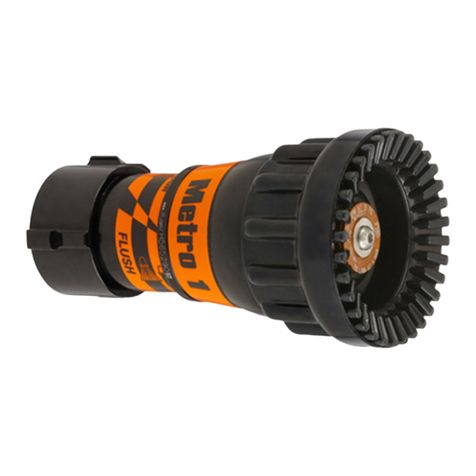
Task Force Tips
Task Force Tips METRO 1 Series INSTRUCTIONS FOR SAFE OPERATION AND MAINTENANCE
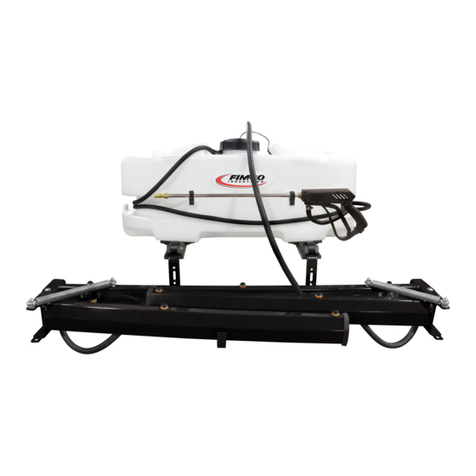
Fimco
Fimco ATV-25-71-QR owner's manual

Makita
Makita EVH2000 Original instruction manual
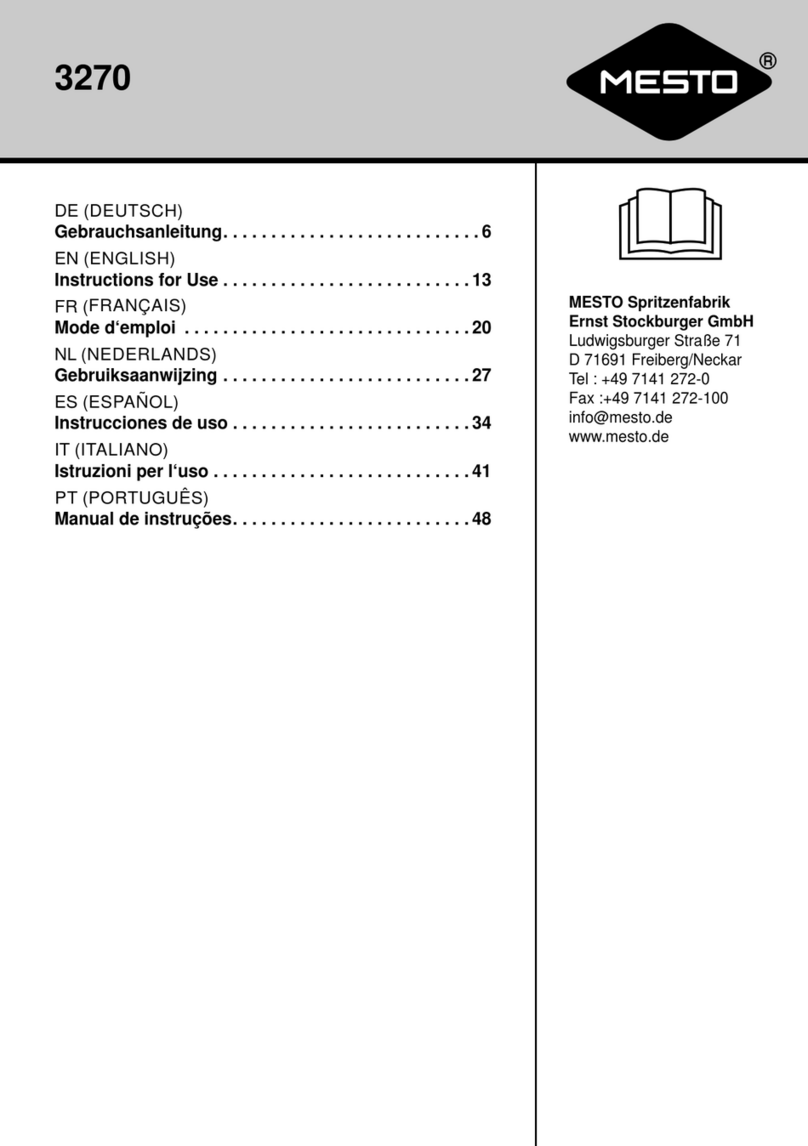
Mesto
Mesto 3270 Series Instructions for use

SATA
SATA SATAjet 1500 B operating instructions
